Exploring Customizable Skateboard Decks for Personal Expression
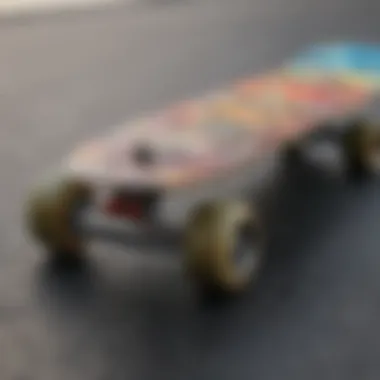
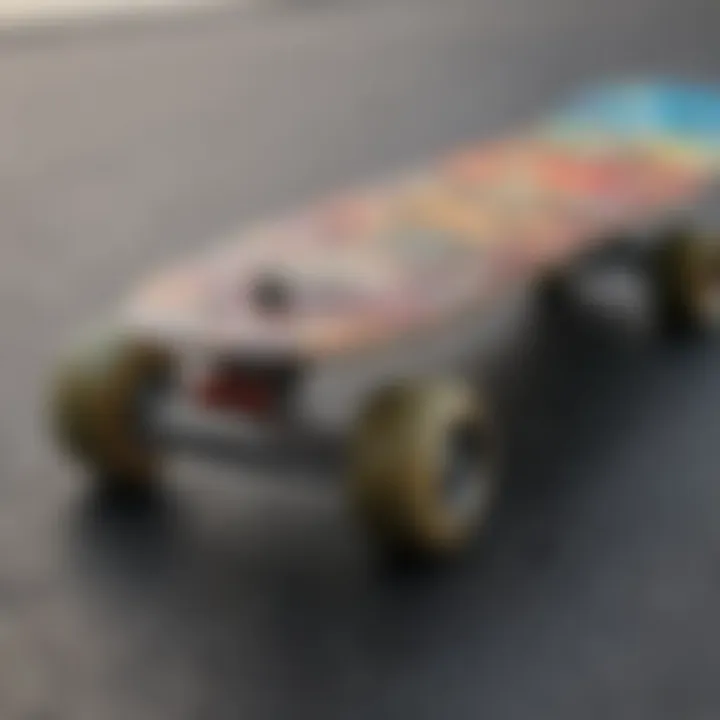
Intro
Customizable skateboard decks have transformed from mere planks of wood into a canvas for personal expression and creativity. In an era where individuality reigns supreme, skaters are seeking to convey their unique styles through their setups. The art of deck customization stands at the intersection of function and self-expression, resulting in a rich tapestry that not only influences how a skateboard performs but also reflects the personality of its rider.
Skateboarding is more than a sport; it’s a culture with deep roots and a vibrant community. The customization of decks allows enthusiasts to break free from the confines of uniformity, ushering in a wave of innovation in design. This article guides readers through the essential techniques and skills involved in customizing skateboard decks, the evolution of skateboarding culture, and how influential figures have left their mark on the craft. Ultimately, it offers insights for skaters, hobbyists, and instructors, weaving together the narrative of skateboarding gear's continual evolution.
This insightful exploration not only emphasizes the intricacies of customizing decks but also highlights the importance of craftsmanship and the materials that play a pivotal role in achieving a personalized ride. The balance between aesthetics and performance is crucial, and exploring this topic provides a comprehensive understanding of why custom decks are more than just a trend; they are a fundamental aspect of skateboarding today.
As we delve deeper, let’s uncover the technical aspects that make the art of customizable skateboard decks a worthwhile pursuit.
Techniques and Skills
When it comes to customizing skateboard decks, knowing the ropes can genuinely enhance both the ride and the personal flair of the board. Being able to shape your own board or modify existing ones opens doors to more than just performance improvements; it invites a journey of self-discovery.
Essential Tricks for Beginners
- Grip Tape Application: Proper application of grip tape plays a colossal role in ensuring the skateboard is secure underfoot. Start with cleaning the surface, cutting the tape accurately, and applying it smoothly to prevent bubbles.
- Deck Painting and Graphics: Beginners might opt for simple paint jobs or stenciled designs //the process can be as simple as using spray paint, or more intricate with brush techniques. Just remember, the more personal it is, the more it reflects you.
- Stickers and Decals: Adding stickers can be a quick and effective way to customize a deck; it’s also a reflection of individual interests and inspiration.
Advanced Techniques for Pros
For those who have some experience under their belts, advancing to more technical customization can elevate a skateboard’s performance significantly.
- Wood Lamination: This involves layering different types of wood to craft a bespoke board that meets specific performance criteria. The right lamination techniques ensure the board has the perfect mix of flexibility and strength to handle tricks and jumps.
- Electric Tools and Shaping: Professionals might employ power tools to shape and refine their decks meticulously. Using a router could allow for creative designs that alter the board’s feel during skate.
- Custom Graphic Printing: For a completely personalized touch, skaters can consider using heat transfer printing for intricate designs that showcase their style.
Customizable skateboard decks symbolize a fundamental ethos of creativity, individuality, and community within the skateboarding culture. As we explore this further, it’s essential to remember that each modification goes hand-in-hand with unique stories and expressions that define both the skateboard and the skater.
Foreword to Customizable Skateboard Decks
In the world of skateboarding, customization is not just a trend; it's a vital component that reflects individuality. Customizable skateboard decks allow skaters to tailor their gear to their preferences and performance needs. The importance of this topic flows from the integration of personal style with functionality, shedding light on the dual nature of skateboarding—as an art form and a sport.
Understanding the Appeal
For many skaters, a deck is not merely a piece of equipment, but an extension of their identity. From vibrant graphics to unique shapes, the appeal of customizable decks lies in the power of personal expression. A skateboard becomes a canvas where skaters artistically collaborate with brands or designers to create something that resonates with their personality. This customization not only enhances aesthetic value but also reinforces a sense of belonging to a skateboarding community.
Customizable decks are especially alluring because they convey individuality in a world where conformity can often feel like the norm. As a result, skaters, whether they're cruising through city streets or practicing tricks at a local skate park, sport decks that resonate with their unique stories. Additionally, these decks can also reflect current trends, cultural movements, or even personal milestones, enhancing their significance beyond the board itself.
The Relationship Between Skaters and Their Equipment
The bond between skaters and their decks goes beyond mere functionality. It's a relationship built on trust, identity, and shared experience. Each scratch, each paint chip on a skateboard tells a story—a representation of countless hours spent practicing new tricks or navigating obstacles. For many, their deck is like an old friend that has been there through thick and thin.
"The deck you ride is as personal as the shoes you wear; they carry a piece of your soul."
In practical terms, the choice of skate deck influences performance. Different shapes and materials yield varying degrees of flexibility, durability, and grip. This means that a skater often spends considerable time choosing a deck that matches their specific style and abilities. Furthermore, the customization process elevates this selection journey, allowing skaters to choose even the smallest details, from the flex of the wood to the artistry on the top, ensuring it feels just right underneath their feet.
Materials Used in Skateboard Decks
When you think of a skateboard deck, what material comes to mind? Most people picture the smooth, glossy finish of wood. However, the materials utilized in skateboard decks can markedly influence performance, durability, and even the overall aesthetic. This section delves into the spectrum of materials employed in skateboard deck production, highlighting not just types but also the benefits they carry, and considerations skaters might weigh when customizing their boards.
Types of Wood and Their Properties
Skateboard decks are predominantly made from various types of wood, with maple and birch taking the lead.
- Maple: This is the gold standard for skateboard decks. Hard maple wood provides a balance of durability and flexibility. It can absorb shocks well, which is critical for those high-impact tricks. The wood’s fine grain also allows for a smooth finish, making printing graphics more vibrant.
- Birch: Another solid choice, birch is slightly lighter than maple. This can offer skaters a quicker response during tricks. Birch boards also tend to be more affordable, making them a good entry-level option.
- Plywood: Composed of layers of wood veneer, plywood boards are not entirely uncommon. They can be more affordable than solid woods but may lack the same level of responsiveness and performance.
Each type of wood comes with its characteristics that affect performance. Hardwoods like maple often hold shape well over time, giving a consistent feel underfoot. On the flip side, lighter woods might offer a more agile experience, which can be advantageous for tricks but could sacrifice longevity.
Alternative Materials in Deck Production
While wood has been the traditional choice, some manufacturers have begun experimenting with alternative materials to cater to a new wave of skaters seeking unique experiences and sustainability.
- Bamboo: Bamboo is rapidly gaining traction in the skateboard industry. Not only is it renewable, but it also boasts an impressive strength-to-weight ratio. Skaters love bamboo for its flex and ability to absorb vibrations, reducing fatigue during long sessions.
- Fiberglass and Carbon Fiber: Some high-end decks incorporate fiberglass or carbon fiber layers. These materials can make a board exceptionally stiff, ideal for those who favor speed and stability over flex. They are often designed for professionals or serious amateurs due to their price tag.
- Recycled Materials: In an age where sustainability matters, various companies utilize recycled plastics for skateboard decks. These decks are not just environmentally friendly but also often provide a unique look and feel that can stand out on the skatepark.


"By integrating alternative materials, skaters can express individuality while being mindful of their environmental footprint."
In addition to performance, skaters also need to factor in weight, feel, and visual appeal when selecting their desired materials. Thus, a well-informed choice can elevate not only the experience but also the connection one has with their skateboard. The choice of materials can be as personal as the designs chosen, turning a simple board into a tailor-made extension of the skater’s identity.
Design Considerations for Customizable Decks
When it comes to skateboard decks, design is not merely about aesthetics; there’s a whole science behind it. Various elements shape how a skateboard looks and performs, making the selection of each aspect crucial for skaters. Understanding design considerations helps enthusiasts create a board that is both beautiful and functional.
Graphics and Aesthetics
In the realm of skateboarding, graphics hold a significant place. They serve not just as eye candy but also as a means of self-expression. Many skaters choose to customize their decks with designs that resonate with their personality or convey their artistic style. It’s commonplace to see someone sporting a deck that reflects their favorite band, art style, or even a favorite quote.
Moreover, the graphical representation impacts the overall branding and identity of a skateboarder. A good design goes beyond mere visual appeal; it tells a story. For instance, consider a deck with vibrant, graffiti-like designs inspired by urban culture. This instantly connects the skater to the street culture that birthed most skateboarding techniques. People often notice decks even before they see the rider; that’s the power of graphic design.
When choosing graphics, skaters must think about the printing method as well. Some inks and processes wear out quicker than others. A skater may find that a vinyl wrap might look good initially but could fade or peel off with use. Similarly, murals painted directly on wood might offer more durability but have less vibrancy. The right balance of aesthetics and longevity is an important decision in the customization process.
Shape and Size Variations
Shape and size can make a world of difference in how a deck rides. Skateboard decks cater to various styles, ranging from street skating to vert through a variety of shapes and sizes. While many skaters may prefer a traditional popsicle shape, others might lean toward wider options for more stability.
Different shapes serve unique functions. For example, a tapered tail allows for sharper turns, while a wider front provides more surface area for landing tricks. It is helpful to consider what you most want to achieve while skating. Here are a couple of common shapes:
- Popsicle shape: Ideal for street and park skating. It allows for a good balance of flip tricks and landings.
- Cruiser shape: Favors smoother, more accessible rides. Suitable for casual skaters or those just looking to zip around.
Size also plays a critical role. A larger deck can provide added stability, perfect for beginners or those focusing on transition skating. On the flip side, a narrower deck can enhance maneuverability, making it easier to flick and spin. Understanding the interplay between size and shape can help any skater make informed decisions according to their preferences.
In selecting both graphics and structural elements, skaters turn their decks into an extension of their identity. These choices reflect not only personal taste but also relate to performance styles. Thus, the design considerations carry weight beyond mere looks; they bridge artistry with athletic craftsmanship.
Customization Tools and Techniques
When it comes to skateboard decks, customization is no longer just a luxury; it’s a vital part of skate culture. The right tools and techniques can make all the difference for skaters looking to express their individuality and enhance performance. Understanding these elements is key to appreciating what goes into crafting a truly unique board.
Online Customization Platforms
In today's digital age, online platforms have revolutionized the way skaters can personalize their decks. Websites such as Custom Skateboards and Zazzle offer user-friendly interfaces allowing anyone—be it a novice or a seasoned pro—to design their own skateboard deck from scratch. The process is quite simple: users can select shapes, sizes, and artwork, or even upload their own graphics. This convenience not only empowers skaters to get creative but also opens doors for collaborations with artists who share unique perspectives on design.
Here are some benefits of using online customization platforms:
- Ease of Use: Most platforms have intuitive design tools, which means you don’t need to be technologically savvy to create something special.
- Diverse Options: With countless graphic styles and deck shapes available, skaters can explore various combinations to express their personality.
- Preview Feature: Before placing an order, users often get a 3D model of their design allowing them to visualize how it will look when finished.
However, one must also consider the trade-offs. While online platforms offer immense flexibility, they can sometimes feel impersonal. A skater might find that their creativity is limited by what the platform offers, which brings us to the next method of personalization.
DIY Methods for Personalization
For those seeking a more hands-on approach, do-it-yourself (DIY) methods provide unmatched opportunity for authentic expression. Customizing a skateboard deck at home can be a rewarding experience, turning the deck into a canvas that reflects the skater's style.
There’s a variety of ways to personalize your skateboard:
- Painting: Using spray paint or brushes to add color and design can create a deck that looks entirely unique. Just make sure to use non-toxic materials that don’t compromise stability.
- Stickers and Decals: These are an easy and effective way to add flair. They can be purchased or made at home, providing an endless range of designs.
- Burning Designs: For the more adventurous, wood-burning tools can create intricate designs on the deck’s surface, offering high levels of customization.
- Vinyl Wraps: This method involves covering the deck with a vinyl sheeting designed to withstand wear and tear while providing a fresh look.
DIY methods, however, come with their own challenges. As gratifying as it is to create one’s design, it requires a degree of skill and commitment. Mistakes can sometimes lead to unsatisfactory results, which makes practice important.
"Customization is as much about the process as the result. Each scratch and modification tells a story of the skater’s journey."
In the end, whether using online platforms or taking the DIY route, what matters is that the end product resonates with the skater. Each method offers its own set of advantages and challenges, ultimately culminating in a piece of gear that’s not just functional but also a true reflection of the individual using it.
The Market for Customizable Skateboard Decks
The market for customizable skateboard decks has exploded in recent years, becoming a dynamic canvas for personal expression. We see more skaters than ever wanting to put their own stamp on their gear. This shift is mostly fueled by a growing recognition that skateboards are more than just tools for tricks; they are also a form of individual and artistic expression. Custom decks allow skaters to shout their identity through both style and performance, fostering a sense of ownership and pride in their equipment.
Understanding this market involves unraveling several layers: the trends guiding consumer demands, the influence of brand collaborations, and the increasing importance of personalization in this competitive landscape. Customizable decks aren't simply a revenue generator for brands; they represent a cultural shift that resonates deeply with skater communities. Businesses that tap into this phenomenon can benefit significantly, but they must also navigate preferences that can shift like sand underfoot.
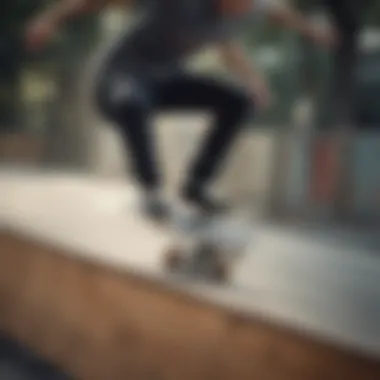
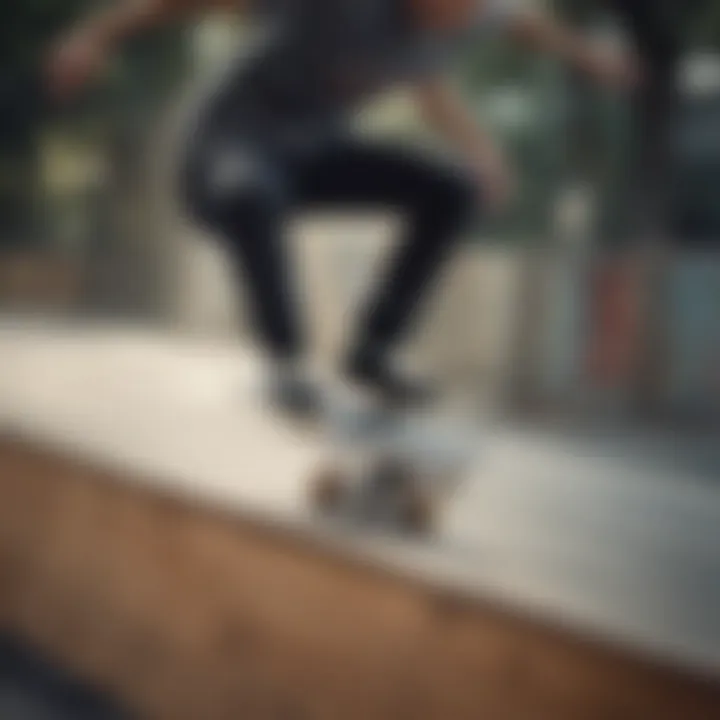
- Cultural Resonance: As skateboarding becomes more mainstream, individuals are searching for ways to set themselves apart. Custom decks reflect personality traits, interests, and artistic visions.
- Enhanced Engagement: To stand out in the flood of skateboarding brands and products, companies are offering more customizable options, tapping into the desire for personal connection with their gear.
- Digital Influence: With the rise of online platforms facilitating design customization, accessibility to bespoke options has surged. This makes it easier for enthusiasts to delve into creating their dream decks.
"Customizable decks elevate skateboarding from just a sport to a lifestyle, allowing each rider to express their unique flavor of creativity."
Emerging Trends in Skateboard Design
The world of skateboard design is constantly evolving, with several trends emerging that shape how skaters think about their decks, especially in customization. First and foremost is the increasing integration of technology in design processes. Skateboards are no longer just planks of wood; companies are now incorporating smart technology that tracks performance metrics or utilizes augmented reality for deck design previews.
A few other notable trends include:
- Sustainable Practices: Consumers demand eco-friendly materials and production processes. Many brands now offer decks made from reclaimed wood, environmentally safe inks, and sustainable glues.
- Artistic Collaborations: With artists from different fields entering the skateboard scene, collaborative designs often feature unique aesthetics, combining street art with graphic design.
- Personalized Graphics: Advances in printing technologies allow users to create intricate designs that reflect their identity. Skaters often choose patterns, images, or text that resonate with their life experiences or beliefs.
The Impact of Brand Collaborations
When it comes to brand collaborations, the impact is significant and multifaceted. Not only do partnerships with artists, musicians, and other creative professionals enrich the visual landscape of customizable decks, but they also forge emotional connections between skaters and brands. Such collaborations often lead to limited-edition designs, which create a sense of urgency and exclusivity that can propel sales.
- Visibility and Innovation: By working together, brands can amplify their visibility in niche communities, attracting a varied audience that may have previously overlooked them.
- Doubling Down on Trends: Collaborations often help brand rally around current trends in culture, making them more relevant and relatable in the eyes of consumers.
- Customer Loyalty: A successful collaboration can enhance customer loyalty, as consumers begin to associate brands with positive experiences or cultural moments reflected in the skateboarding scene.
Each of these elements contributes towards solidifying the position of customizable skateboard decks in the marketplace. They do more than ride on trends; they carve out new paths, influencing how skaters view their equipment and express themselves through it.
Influence of Personalization on Performance
In the vast landscape of skateboarding, the performance of a rider can greatly depend on the specifics of their skateboard deck. Personalization plays a significant role in aligning a skater’s needs with their equipment, and understanding this relationship is crucial for anyone serious about mastering the art of skating.
Balancing Style with Functionality
When it comes to skateboard decks, striking a balance between style and functionality is no small feat. A deck that looks good might not necessarily perform well, and vice versa. Skaters need to navigate the delicate line between aesthetic appeal and practical performance. Deck graphics, color schemes, and the overall design can be vibrant and eye-catching. However, if these elements compromise the grip or the overall sturdiness of the deck, the effectiveness diminishes quickly.
For instance, many skaters prefer decks with a certain texture or grip tape that aligns with their skating style. A well-designed deck offers both visual intrigue and the grip necessary for tricks. This interplay is essential—what's hidden in the beauty of the art can sometimes overshadow the underlying functionality that allows for successful skating. To summarize, some things to consider include:
- The impact of artwork on grip and maneuverability
- The material's ability to withstand wear and tear while still looking its best
- Custom deck shapes that may influence the slalom or flip tricks
Tailoring Decks to Individual Skill Levels
Every skater is unique, often defined by their skills, personal preferences, and the level of tricks they can execute. Tailoring decks to fit individual skill levels can enhance performance considerably. Consider the experience of a beginner versus an expert rider; they require different specs and designs to meet their unique needs.
Beginning skaters might benefit from wider decks that provide more stability, while seasoned pros may opt for slim, agile decks that facilitate intricate moves and flip tricks. The following factors can influence the choice of deck:
- Width: A wider board offers better stability for beginners. In contrast, more experienced skaters may prefer narrower widths for precision and control.
- Material: Advanced materials can offer better shock absorption or lighter weight, which is vital for techniques like ollies or kickflips.
- Shape: Tailoring the shape can enhance performance. For instance, a concave shape allows for better foot grip during tricks.
By carefully personalizing their board, skaters are not just customizing their deck for looks; they are directly influencing their performance outcomes. The intricacies of these choices underscore the complexity and beauty of customizable skateboard decks, illustrating how personal preference intertwines with practical application.
"A customized skateboard deck isn't just a canvas; it's an extension of a rider's identity and skills, perfectly blending individual flair with functional capability."
In summary, personalization is at the heart of performance in skateboarding. The choices one makes in deck customization can transform the skating experience, leading to enhanced performance and artistic expression.
Cultural Significance of Customizable Decks
Customizable skateboard decks hold more than just functional value in the skateboarding world; they are a canvas for personal expressions, cultural messages, and affirmations of identity. The act of customizing a deck transcends mere aesthetics, tapping into an intricate tapestry of subcultures and personal stories. Each unique design reflects the tastes, emotions, and even the social standing of the skater.
Skateboard Decks as a Medium of Expression
For many skaters, a skateboard deck is not just a piece of wood to ride on but a reflection of who they are. Through vibrant graphics, personalized shapes, or even the choice of materials, each skater communicates something about their identity to the world. This customization encapsulates personal ethos; for instance, a skater who opts for eco-friendly materials may be sending a strong message about environmental awareness, while someone showcasing elaborate artwork might be emphasizing creativity and artistic inclination.
The significance of customization is echoed across various subcultures within skateboarding. Some might prefer minimalistic designs that highlight the beauty of raw materials, while others may adorn their decks with intricate designs that resonate with punk rock aesthetics or street art influences. In this way, one can draw parallels between skateboard decks and other forms of art, such as painting or graffiti – they both serve as powerful tools for communication.
Moreover, as the sport evolves, so does the art of deck design, with innovative techniques allowing skaters to express themselves in ever more unique ways. For instance, the rise of digital design platforms has made it easier for creatives to manipulate graphics and images to fit their personal vision, making the once tedious process faster and more accessible.
"A customized deck carries the essence of its rider and tells a story with every trick."
Community and Identity Within Customization
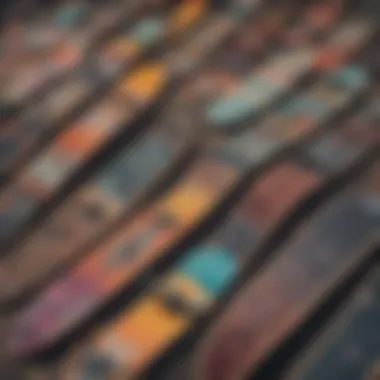
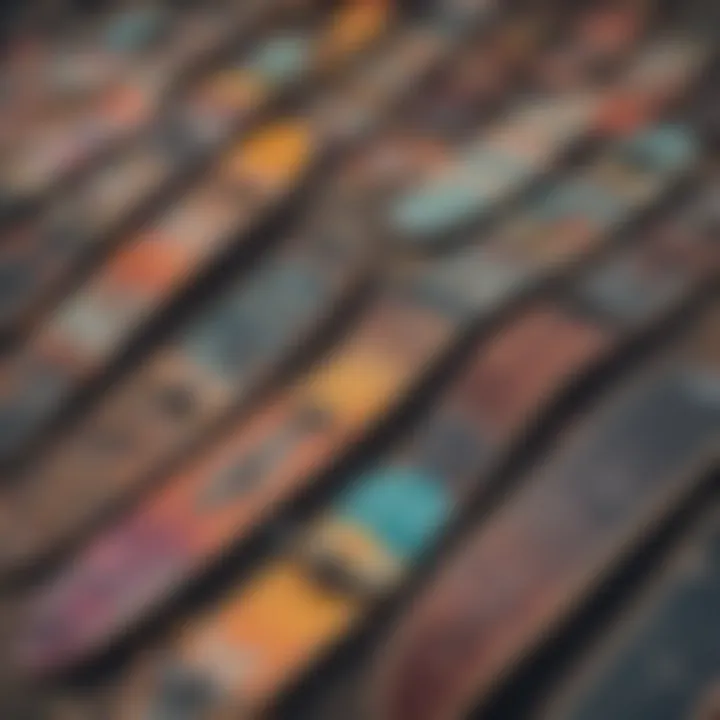
The compelling aspect of customizable skateboard decks also lies in the sense of community they foster. When skaters come together to share their designs, they create a bond whose strength is fueled by shared values and experiences. Customization facilitates conversations about art, technique, and even deeper philosophical ideas underlying skate culture.
The practice of customizing decks often becomes a communal affair. Local shops may host workshops, encouraging skaters to collaboratively design and create together. This creates a sense of belonging. Not only do they share their designs, but skaters also share tips, techniques, and histories attached to their styles, which fosters a deeper understanding of their craft and culture.
Within groups, customized decks serve as badges of identity. They evoke a sense of pride and signify an affiliation to specific communities or movements. This sense of belonging can be especially meaningful for younger skaters, providing them with a gateway to form friendships based on shared passions.
In sum, customizable skateboard decks go far beyond functionality. They are symbols of personal and cultural identity that resonate deeply with the skater community. By exploring the interplay of art, social identity, and community ties, we reveal a vibrant landscape that celebrates individuality while fostering connection among skaters.
Sustainability in Deck Production
The need for sustainability in skateboard deck production has become a crucial topic as more skaters look to balance their passion with an awareness of environmental impacts. Skateboarding is often seen as a sport deeply connected to urban culture and individuality, but behind the scenes, the materials and methods used in deck production can tell a different story. Pressing needs for eco-friendly practices and sustainable materials are now influencing both the manufacturers and consumers of customizable decks.
Eco-Friendly Materials and Practices
When diving into the realm of sustainable skateboard production, the focus primarily lands on the materials. A significant number of traditional skateboard decks are made from a type of wood known as maple, specifically hard rock maple. While it’s durable and widely revered among skaters, the environmental footprint can be considerable, given that it often comes from large-scale deforestation.
Fortunately, manufacturers are turning to alternative woods and even synthetic materials that offer a more eco-conscious approach. Here are a few examples of eco-friendly options:
- Bamboo: Light and sturdy, bamboo grows faster than conventional woods and can be harvested without killing the plant.
- Recycled Materials: Some companies are producing decks from recycled plastic or even repurposed skateboards, emphasizing a circular economy.
- Sustainable Sourcing: Brands like Element and Arbor have committed to using sustainably sourced woods. They not only reduce strain on forests but also create a marketing highlight that attracts eco-minded consumers.
In addition to materials, manufacturing practices also play a mighty role. Many companies are now adopting water-based glues instead of solvent-based ones. This small change has a less harmful effect on air quality in factories.
"Every board we create impacts the world around us; it’s time we pay it forward through sustainable choices." - A leading skateboard manufacturer.
Consumer Choices and Environmental Impact
As skaters become more conscious of their choices, consumer behavior is shifting towards brands that prioritize sustainability. Just like the unique designs on their decks, skaters are beginning to paint their values onto their purchasing habits. They want to know that their decks are not just a product of great craftsmanship, but also reflect an ethical stance towards the planet.
Some key factors in consumer choices include:
- Transparent Supply Chains: Skaters appreciate brands that can trace their materials from source to product, ensuring ethical practices.
- Community Impact: Consumers also favor companies that engage with their communities, whether through local events or support for youth programs.
- Durability and Lifespan: Investing in a deck that lasts longer not only improves performance but also minimizes waste.
This growing awareness is reshaping product offerings as manufacturers respond to consumer demand. Customizable decks that highlight eco-friendly materials are trending, offering skaters a way to express their identity while being part of a larger movement towards sustainability.
Future of Customizable Skateboard Decks
The world of skateboarding is ever-evolving and so is the technology that supports it. In the future, customizable skateboard decks will not only reflect individual artistry but also incorporate advancements that enhance their performance and sustainability. This section delves into the unfolding landscape that shapes customizable decks, reflecting the inseparable bond between skaters and their boards. Understanding this future is crucial for anyone who loves skateboarding, whether for fun, sport, or art.
Technological Innovations in Production
As we look ahead, the potential for technological innovations in the production of customizable skateboards is both exciting and inspiring. With the advent of 3D printing, for example, skateboards could be produced with a level of intricacy that was previously inconceivable. This method allows for tailored designs that suit a skater's specific style and performance needs. Imagine a deck not just colored in your favorite hues but also engineered to mold perfectly to your ride style—each curve and contour crafted for your unique footprint.
Moreover, advances in material science could lead to the use of lighter, yet stronger composites, which would enhance durability and performance.
- Smart Technology Integration: Incorporating smart technology could be a game changer. Imagine decks equipped with sensors that can measure jump height, speed, and balance, providing real-time feedback for improvement.
- Eco-Friendly Practices: Innovations focusing on sustainability are also gaining traction. With biodegradable materials and processes that reduce waste, the future decks could contribute to a greener planet.
What does this mean for skaters? It implies a future where every deck can be not only personalized to their heart's content but also optimized for performance through cutting-edge technology.
The Evolving Relationship Between Skaters and Their Decks
The relationship between skaters and their equipment has always gone beyond mere functionality. It is deeply personal. A skateboard is often seen as an extension of one’s identity. In the future, this connection will likely deepen as technology bridges the gap between the art of skating and the science of performance.
- Personalization Variants: As customization tools become more sophisticated, skaters might be able to select from a plethora of designs, shapes, and even responsive technologies that adapt to their skating environment.
- Community Engagement: With online platforms increasingly allowing skaters to collaborate on designs and share their personalized decks, there will be a surge in community-driven innovations. Skaters won’t just be consumers; they will become co-creators, giving rise to unique design trends influenced by local skate culture.
“A skateboard is not just a tool for movement; it is an art form that captures the essence of the individual riding it.”
This evolving landscape suggests that soon, each board will tell a story, reflect personal journeys and showcase complex layers of artistry mixed with performance. As technology progresses, the dynamic between skaters and their decks will flourish like never before.
The End: The Intersection of Art and Functionality
In the world of skateboarding, customizable decks are not just mere tools for riding; they stand as a testament to the rider's personality and creativity. The blending of art and functionality creates a unique space where individual expression meets performance requirements. Every skater has a distinct style and preference, and customizable decks allow for this variance to shine through. Therefore, understanding how to achieve the right balance between aesthetics and usability is essential for both enthusiasts and manufacturers.
When we consider customization as a core aspect, it becomes clear that it is an art form. The designs and graphics that adorn a skateboard deck often reflect cultural influences, personal experiences, and even artistic movements. This type of personalization speaks volumes about the rider, making the deck an extension of their identity. Therefore, each customized deck serves as a canvas – from vivid murals to minimalist designs, every choice influences the narrative presented to the world.
However, while aesthetics play a vital role, function cannot be overlooked. Skating is an intense and dynamic sport, requiring decks to endure a significant amount of wear and tear, adapt to tricks, and accommodate the skater's style. The materials used, the shape of the deck, and the distribution of flex are all crucial considerations. Thus, blending the artistry in the design with the functional aspects of the deck enhances the overall skating experience. Good customization ensures that the deck not only looks good but also performs optimally.
"A skateboard deck is more than just wood; it is a medium for self-expression that performs under pressure."
In creating a personalized deck, skaters should be mindful of their own skill levels and intended use. A professional skater might gravitate toward a specific shape that enhances performance, while a casual rider may prioritize the artistic representation of their personal journey. Such decisions are pivotal and highlight the importance of individual preference in creating a board that aligns with one's skating ethos.
Ultimately, the intersection of art and functionality in customizable skateboard decks underscores the deep connection between the skater and their equipment. This relationship is about much more than just riding; it's about embracing what they represent in the realm of skateboarding culture.







